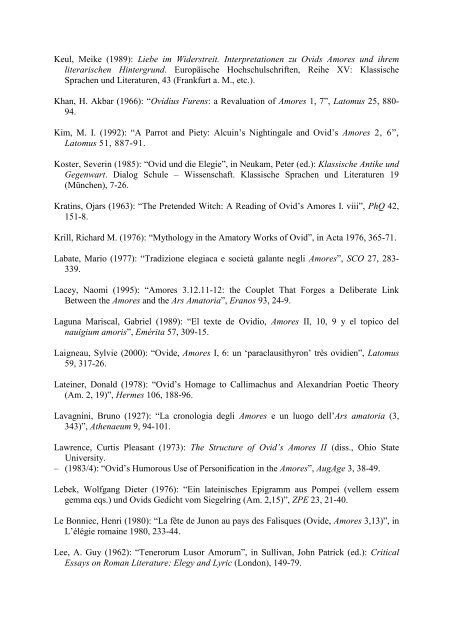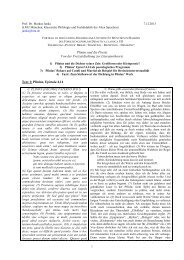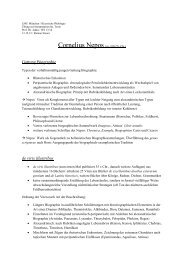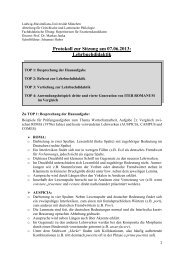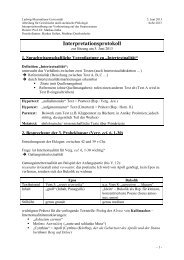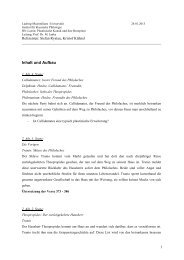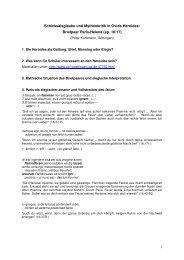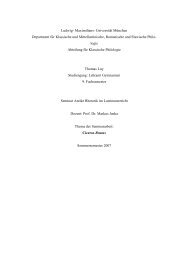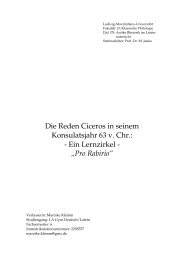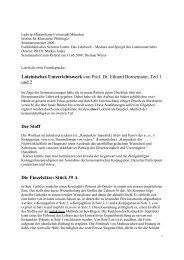PDF-Dokument öffnen
PDF-Dokument öffnen
PDF-Dokument öffnen
You also want an ePaper? Increase the reach of your titles
YUMPU automatically turns print PDFs into web optimized ePapers that Google loves.
Keul, Meike (1989): Liebe im Widerstreit. Interpretationen zu Ovids Amores und ihrem<br />
literarischen Hintergrund. Europäische Hochschulschriften, Reihe XV: Klassische<br />
Sprachen und Literaturen, 43 (Frankfurt a. M., etc.).<br />
Khan, H. Akbar (1966): “Ovidius Furens: a Revaluation of Amores 1, 7”, Latomus 25, 880-<br />
94.<br />
Kim, M. I. (1992): “A Parrot and Piety: Alcuin‟s Nightingale and Ovid‟s Amores 2, 6”,<br />
Latomus 51, 887-91.<br />
Koster, Severin (1985): “Ovid und die Elegie”, in Neukam, Peter (ed.): Klassische Antike und<br />
Gegenwart. Dialog Schule – Wissenschaft. Klassische Sprachen und Literaturen 19<br />
(München), 7-26.<br />
Kratins, Ojars (1963): “The Pretended Witch: A Reading of Ovid‟s Amores I. viii”, PhQ 42,<br />
151-8.<br />
Krill, Richard M. (1976): “Mythology in the Amatory Works of Ovid”, in Acta 1976, 365-71.<br />
Labate, Mario (1977): “Tradizione elegiaca e società galante negli Amores”, SCO 27, 283-<br />
339.<br />
Lacey, Naomi (1995): “Amores 3.12.11-12: the Couplet That Forges a Deliberate Link<br />
Between the Amores and the Ars Amatoria”, Eranos 93, 24-9.<br />
Laguna Mariscal, Gabriel (1989): “El texte de Ovidio, Amores II, 10, 9 y el topico del<br />
nauigium amoris”, Emérita 57, 309-15.<br />
Laigneau, Sylvie (2000): “Ovide, Amores I, 6: un „paraclausithyron‟ très ovidien”, Latomus<br />
59, 317-26.<br />
Lateiner, Donald (1978): “Ovid‟s Homage to Callimachus and Alexandrian Poetic Theory<br />
(Am. 2, 19)”, Hermes 106, 188-96.<br />
Lavagnini, Bruno (1927): “La cronologia degli Amores e un luogo dell‟Ars amatoria (3,<br />
343)”, Athenaeum 9, 94-101.<br />
Lawrence, Curtis Pleasant (1973): The Structure of Ovid’s Amores II (diss., Ohio State<br />
University.<br />
– (1983/4): “Ovid‟s Humorous Use of Personification in the Amores”, AugAge 3, 38-49.<br />
Lebek, Wolfgang Dieter (1976): “Ein lateinisches Epigramm aus Pompei (vellem essem<br />
gemma eqs.) und Ovids Gedicht vom Siegelring (Am. 2,15)”, ZPE 23, 21-40.<br />
Le Bonniec, Henri (1980): “La fête de Junon au pays des Falisques (Ovide, Amores 3,13)”, in<br />
L‟élégie romaine 1980, 233-44.<br />
Lee, A. Guy (1962): “Tenerorum Lusor Amorum”, in Sullivan, John Patrick (ed.): Critical<br />
Essays on Roman Literature: Elegy and Lyric (London), 149-79.


